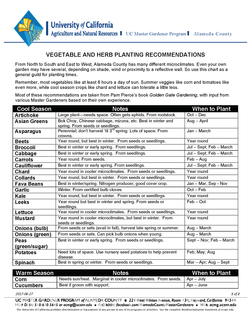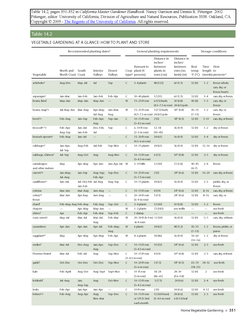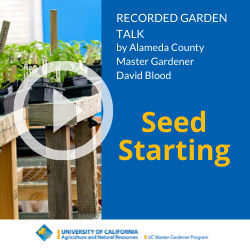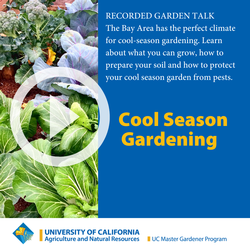Cool Weather Vegetable Gardening
Late Summer or Early Fall is the Time to Plan and Plant
by Diane Allen
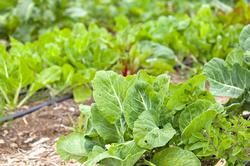
Why Start Cool Season Crops in Late Summer
You may be asking “Isn’t it too early to talk about this now? My tomatoes have just started to get ripe!” The answer is that as our summer vegetables begin to slow production in late July and August, it’s the perfect time to sow new seeds and plant seedlings for the cooler months. This lead time will give your cool-season seeds time to germinate and the seedlings time to get established before cold winter temperatures arrive. Cool-season plants also like a warm start, so it's not too early to begin adding some of them to the vegetable garden now.
What Are Cool Season Vegetables
Cool-season crops are those that grow best and produce the best quality when the average temperatures are 55*F to 75F and are usually tolerant of slight frosts. There is a large variety of these vegetables to choose from.
Brassica, plants in the cabbage and mustard family
Vegetables that do well in our cool months include members of the Brassica genus (cauliflower, broccoli, Brussels sprouts, cabbage, collard greens, turnips, bok choy, and kale). In addition to growing well in cooler weather, brassicas are less susceptible to cabbage moths when the weather is cooler.
Leafy greens and herbs
Leafy greens such as spinach, lettuce, arugula, and Swiss chard also grow very well in cooler months, as do leafy herbs such as parsley and cilantro. In fact, many of these vegetables grow more abundantly in cooler weather and do not bolt to seed as easily as they do during hot summer days.
Onions and Garlic
Both bulb and green onions can be planted this fall for a late spring or early summer harvest, or this winter for a late summer or fall harvest next year. Garlic is generally best planted in the fall for the largest size bulbs at harvest. While garlic is fairly easy to grow, see below for practical tips for onion gardening success - they are more complicated than it seems.
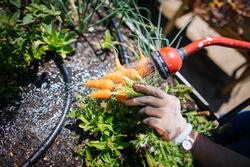 Carrots, beets, peas … plant again for the second crop
Carrots, beets, peas … plant again for the second crop

And don’t forget that some favorite vegetables can be grown all year round in the Bay Area. These include carrots, beets, and peas. These favorites can be planted in early spring for an early summer harvest and planted again in late summer to enjoy a year-round bounty.
When to Plant?
Resources for recommended planting times
It’s important to plant these crops close to the recommended times for each of them, to give young plants and roots time to grow and get established before nighttime temperatures drop later in the fall, usually in November. Then these plants need to mature when the weather is still cool. If they have not had time to mature early enough, some of these plants will bolt and go to seed prematurely when the weather warms.
The following links show tables of the recommended planting times for these cool-weather crops and summer vegetables.
How to Plant?
Seeds can be sown directly into the garden soil at the correct planting time for the crop (direct seeding), or they can be grown indoors for several weeks to create a strong young plant that is later transplanted to the garden. Or, if you prefer to not work with seeds or are just in a hurry, you can purchase young plants from the nursery for transplanting into the garden.
Since seedlings of some of these cool-weather vegetables may not be readily available at your local nursery later in the summer, many gardeners plant seeds of the vegetables that become hard to find, such as broccoli, cabbage, cauliflower, kale, and celery. Sow seeds for root crops (carrots, beets, turnips) directly in the soil, as the process of transplanting can damage the roots.
Start seeds indoors to transplant
You can sow seeds indoors 3-8 weeks before the date you want to plant in the garden. The exact timing will depend upon the time that each crop typically takes to grow from seed to a transplant size seedling. For example, broccoli takes about 6 weeks from seed to transplanting, so broccoli seeds should be started around August 1 to have seedlings ready to transplant in mid-September.
To get an idea of the time from seed to transplant for a variety of vegetables, see the chart that was prepared for Santa Clara county, the seed to transplant time is also an approximation for Alameda County.
Warmth and light for indoor seeds can be provided by a sunny window, an electric light combined with a germination heating mat, or plastic or glass-covered hot box. Seeds should be grown in a seedling mix, either commercially or homemade. An inexpensive home mix is made from 1:1 peat moss: perlite. Never use soil, which can contain pathogens and weeds. Containers can be six-packs, small pots, food containers or drinking cups (make drainage holes), or other specialty products. If containers are new, use them directly, however, if they have been used before you should sterilize them by soaking in 9:1 water:bleach solution. Once the containers are prepared, add the planting mix and water thoroughly to remove any salts. Add seeds to the proper depth given on the seed package, and water from below. Cover pots with glass or clear plastic to keep in moisture and warmth. Seeding mix is generally low in nutrients so you must supply a light application of complete fertilizer once your seedlings emerge. After germination, increase lighting to prevent etiolation (tall, spindly plants).
When moving young plants from indoors or from a hot bed into the garden, the plants must first be hardened off a few hours a day to acclimate them. A plant placed outdoors with no hardening off will sunburn and show signs of stress. To do this, place the plants in a location that gets 2 – 3 hours of sunlight for the first couple of days and bring them inside at night. Then increase the amount of sunlight they receive over the course of a week or so and begin leaving them outside at night after the fourth or fifth day.
For more information on seed starting, see: http://acmg.ucanr.edu/Growing_Your_Own_Food/Planting_Vegetable_Seeds/
Direct Seeding Outdoors
You can also sow the seeds directly into the outdoor garden soil. Carrots, beets, peas, radishes, spinach, and arugula are examples of cool-season vegetables that are very easy to grow by direct seeding; root vegetables like carrots, radishes, and beets do best when sown directly into the soil. Seeding depth is generally never more than 2 – 3 times the seed diameter, and often shallower is better. When direct seeding, plant extra seed and then thin to the recommended spacing within the row.
Remember the weather will still be warm or hot while the seeds are germinating and seedlings emerging, so take care to provide consistent moisture to the seedbeds, especially on warmer days.
Transplant Purchased Seedlings
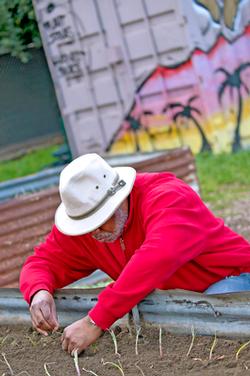
Using transplants can have advantages for some vegetables. For example, lettuce grown for harvest in the fall is planted in August and September, but high temperatures can prevent the seed from sprouting, so transplants of 4 weeks age should be used instead of direct seeding.
Another factor in favor of transplants is saving space in the garden. For example, some summer crops such as tomatoes may continue to be harvested into early fall, during which time cool weather crops like lettuce seedlings can be planted nearby. By using transplants, the tomato crop will remain in place and be fully harvested while a cool weather plant is on its way to maturity.
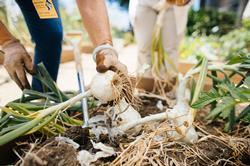 A Word About Onions and Garlic
A Word About Onions and Garlic

Onions
The onion is a biennial plant normally grown as an annual and harvested for its bulbs. When day lengths are short and temperatures cool, onions continuously make normal leaves and roots, and when harvested in this early stage are termed green onions. When day lengths become longer and temperatures increase in the spring, bulbing starts.
When to plant onions
What factors control onion bulb formation? There are many, but the best understood are day-length (photoperiod) and temperature, with day length being the most important factor. The terms “short-day”, “intermediate day”, and “long-day” onion varieties are widely used to describe the different daylight hour requirements for different varieties. Generally, onions grown most successfully in Alameda County are Intermediate-day varieties (needing 12 – 14 hours of daylight). Increasing temperature will increase the rate of bulb development once the required hours of daylight are reached. Since there are dozens of varieties available, some experimentation will be required to find the best varieties for your particular garden. Because growing onions can be tricky, we suggest reading the detailed planting guide. (Flowering, or bolting, is also affected by day length and temperature; to avoid flowering be careful not to plant onions too early).
In Alameda County home gardens, onions can be grown successfully by direct seeding or transplants. The typical time from seed to harvest is about 6 months. You’ll also see onion “sets” in the nursery. These are small onion bulbs, usually less than 1 inch in diameter, which are “sowed” like seeds. Sets are not recommended for use in California, however, because the varieties used are poorly adapted to our climate, and the plants tend to bolt (flower) very early before a bulb crop is formed.
How do you know when the plant is making the bulb? In general when the onion “tops” start falling over you know that bulbs are forming.
Garlic
Garlic is generally best planted in the fall for the largest size bulbs at harvest. Later planting is acceptable, but bulb size may be smaller. Bulb formation begins in response to lengthening days. Most garlic is grown from the separated cloves of the garlic plant rather than from seed. Plant the bulblets directly in the garden. Do not remove the papery covering on the bulblet. Do not break apart the mother bulb until the plant is ready to plant. Plant 2 inches deep and spaced 4 inches apart in the row, with 12 inches between the rows. The larger the bulblet, the larger the bulb of garlic at harvest. Read more about cultivation tips in this planting guide.
Planting Cool Season Succession Crops – “No-Till” Planting
Whether you grow your cool-season vegetables from seeds or transplants, some of your summer vegetables in your garden bed will still be in their prime. The question will come up “what to do about all the plants already growing in the beds”? Previously it was believed by many that plants compete with one another for nutrients and water. The planting bed had to be denuded of the earlier crop and maybe even left fallow for a time before replanting in that space. Newer research shows that plants grow better when a variety of other plants grow nearby. There are several approaches to succession planting.
A crop can be seeded in the place where another plant was harvested.
- The next crop can be planted among the existing crop (intercropping). This has advantages in August since foliage from older plants offers sun protection to tender seedlings.
- Several compatible plants can be planted together to enhance the growth of each or to protect each other from pests, this is known as companion planting.
- The same crop can be seeded at different time intervals for continuous, smaller harvests (successive plantings).
The Master Gardeners of Butte County have written an excellent article on using “no-till” gardening and such succession planting methods that build up the health of the soil.
Other Tips for Cooler Season Plants
Soil
Your garden soil may be somewhat depleted of nutrients while harvesting or removing your summer vegetables. So before planting cool weather crops it’s a good idea to add compost or soil amendment to recondition the soil and replenish those key nutrients.
And, of course, the good irrigation and fertilizing techniques that you practiced in the summer vegetable garden apply to your cool weather crops too. [soils article and testing]
Understand your location in the Bay Area, and in your yard
As always, the microclimates of our Bay Area, and even within your yard, will affect the location and timing of your planting for cool weather. On the east side of the East Bay hills (e.g., Livermore, Pleasanton, and Dublin) late summer temperatures typically are higher than west of the hills (e.g., Albany, Berkeley, and Alameda). Higher temperatures are also found in the sunny side of your garden that has a lot of southern exposure. Watch your local weather forecasts for high temperatures before you plant. Seeds of course can be started indoors regardless of the outdoor weather. But avoid outdoor seed sowing and transplanting seedlings during a heatwave, or the hottest part of the day even on average temperature days.
For gardeners living in the western side of Alameda County, particularly near the bay and influenced by the San Francisco Bay's maritime weather, a useful resource on plant timing is “Plant Recommendations West of the East Bay Hills”
More Information about Cool Weather Vegetables
Our Alameda Master Gardeners have presented an excellent video on Cool Season Gardening v=hc3EYQGzySo
For further information about growing specific vegetables, see
For further suggestions on garden tasks month by month, see:
For further general information on vegetable gardening, see:
References:
- http://acmg.ucanr.edu/Growing_Your_Own_Food/Transplanting_Vegetables/
- http://acmg.ucanr.edu/Growing_Your_Own_Food/Planting_Vegetable_Seeds/
Still need help?
Email us at acmg@ucanr.edu. Or contact us through our website http://acmg.ucanr.edu/Contact_Us/


